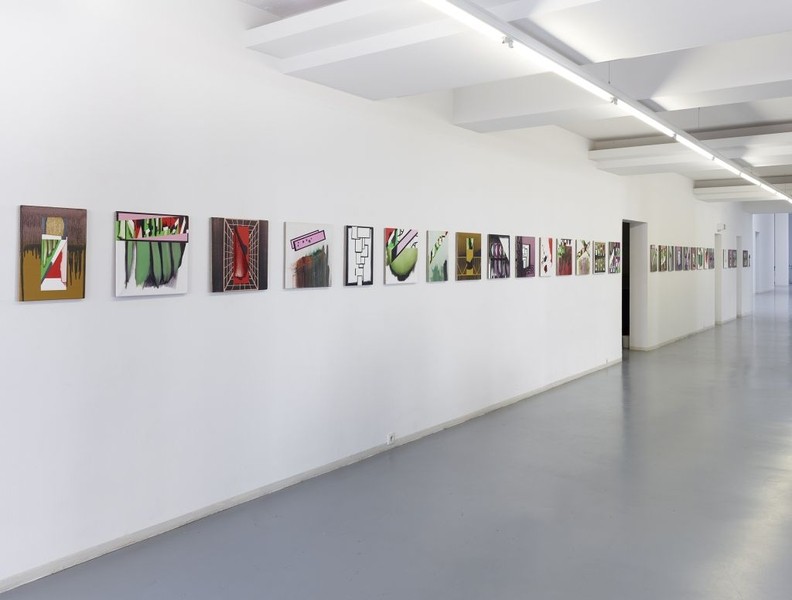Klaus Merkel
07 Mar - 17 May 2015
KLAUS MERKEL
Écart arrière
7 March - 17 May 2015
On occasion of the ars viva presentation in the main hall, KLAUS MERKEL (b. 1953, Heidelberg) presents his exhibition Écart Arrière in the foyer of the Kunstverein, a series of equal-sized canvases that the artist has realized over the course of the last 22 years, all conforming to the same pictorial system. MERKEL conceived his Katalogbilder in the early 1990s: seven large panels on which he presents in a linear sequence all of his work realized from 1988-1995, replicated in a scale of 1:10. From this archive of miniature paintings, he appropriates his own work in order ‘to paint pictures with pictures’. Comparable with abstract rectangular playing card formats, these miniatures can be repeated as such from painting to painting, or can take new shape within the work. Painted on a rich variety of backdrops — from monochromatic fields to perspectival grids to flowing gradients or traces of palette-like brushstrokes— they can appear individually, in sequence, overlaid or freely applied on the picture plane. This self-referential system allowing pictures to be read individually or as an ensemble unleashes a horizon of possibilities detached from any obvious chronology.
While MERKEL’s work strongly inscribes itself into the history and theoretical discourses of painting that raise the question of context, organization and framing, the exhibition Écart Arrière provides a current and direct reading of his works in connection to those tendencies of contemporary art utilizing the internet and digital technologies as a tool. Layered planes, links and cropping reminiscent of computer windows; an endless archive of information; a language related to mathematics that we can’t directly understand; vibrant colors that turn the canvas into a flickering screen; compositions that could have derived from Photoshop — all these examples of painting elements evoke virtual reality on the one hand; and on the other, the synchronicity and simultaneity of the internet. Although KLAUS MERKEL’s painting does not narrate stories, it displays an aesthetic formulation that clearly reacts to the technological developments of its time.
Écart arrière
7 March - 17 May 2015
On occasion of the ars viva presentation in the main hall, KLAUS MERKEL (b. 1953, Heidelberg) presents his exhibition Écart Arrière in the foyer of the Kunstverein, a series of equal-sized canvases that the artist has realized over the course of the last 22 years, all conforming to the same pictorial system. MERKEL conceived his Katalogbilder in the early 1990s: seven large panels on which he presents in a linear sequence all of his work realized from 1988-1995, replicated in a scale of 1:10. From this archive of miniature paintings, he appropriates his own work in order ‘to paint pictures with pictures’. Comparable with abstract rectangular playing card formats, these miniatures can be repeated as such from painting to painting, or can take new shape within the work. Painted on a rich variety of backdrops — from monochromatic fields to perspectival grids to flowing gradients or traces of palette-like brushstrokes— they can appear individually, in sequence, overlaid or freely applied on the picture plane. This self-referential system allowing pictures to be read individually or as an ensemble unleashes a horizon of possibilities detached from any obvious chronology.
While MERKEL’s work strongly inscribes itself into the history and theoretical discourses of painting that raise the question of context, organization and framing, the exhibition Écart Arrière provides a current and direct reading of his works in connection to those tendencies of contemporary art utilizing the internet and digital technologies as a tool. Layered planes, links and cropping reminiscent of computer windows; an endless archive of information; a language related to mathematics that we can’t directly understand; vibrant colors that turn the canvas into a flickering screen; compositions that could have derived from Photoshop — all these examples of painting elements evoke virtual reality on the one hand; and on the other, the synchronicity and simultaneity of the internet. Although KLAUS MERKEL’s painting does not narrate stories, it displays an aesthetic formulation that clearly reacts to the technological developments of its time.

